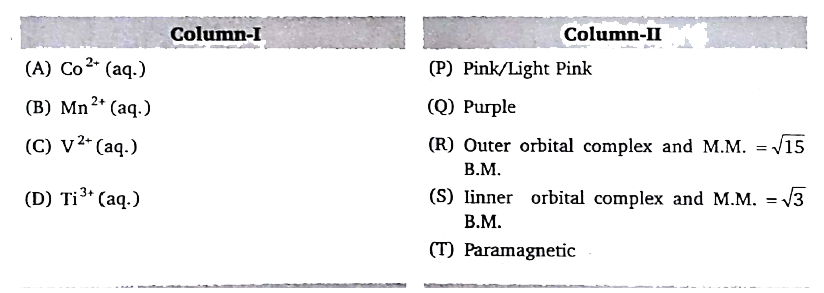Assertion: [CoCl3(NH3)3] does not give white precipitate with AgNO3 solution.
Reason: [CoCl3(NH3)3] complex is optically inactive.
If assertion is true but the reason is false
If assertion is false but reason is true
If both assertion and reason are true and the reason is the correct explanation of assertion
If both assertion and reason are true but reason is not the correct explanation of assertion
The correct Answer is:D
To solve the question, we need to analyze both the assertion and the reason provided.
Step 1: Analyze the Assertion
The assertion states that the complex (CoCl₃(NH₃)₃) does not give a white precipitate with AgNO₃ solution.
- Explanation: When a coordination compound is formed, the ligands (in this case, Cl⁻ and NH₃) are coordinated to the central metal ion (Co³⁺). The complex (CoCl₃(NH₃)₃) has all its chloride ions coordinated to the cobalt ion within the coordination sphere. When AgNO₃ is added, it typically reacts with free chloride ions in solution to form a white precipitate of AgCl. However, since all the chloride ions are part of the coordination complex and not free in solution, no precipitate will form. Therefore, the assertion is correct.
Step 2: Analyze the Reason
The reason states that the complex (CoCl₃(NH₃)₃) is optically inactive.
- Explanation: A complex is considered optically inactive if it has a plane of symmetry or a center of symmetry, which means it cannot rotate plane-polarized light. The complex (CoCl₃(NH₃)₃) is octahedral and has a symmetrical arrangement of ligands (three Cl⁻ and three NH₃). This symmetry leads to optical inactivity. However, while the reason is true, it does not explain why the complex does not give a white precipitate with AgNO₃. The lack of a precipitate is due to the coordination of Cl⁻ ions, not the optical activity of the complex.
Conclusion
- Assertion: Correct
- Reason: Correct, but it does not explain the assertion.
Final Answer
The assertion is correct, the reason is correct, but the reason is not the correct explanation for the assertion.
---
The assertion states that the complex (CoCl₃(NH₃)₃) does not give a white precipitate with AgNO₃ solution.
The reason states that the complex (CoCl₃(NH₃)₃) is optically inactive.
- Assertion: Correct
- Reason: Correct, but it does not explain the assertion.
The assertion is correct, the reason is correct, but the reason is not the correct explanation for the assertion.
Topper's Solved these Questions
- CO-ORDINATION COMPOUNDSBOOK - VK JAISWAL ENGLISHCHAPTER - CO-ORDINATION COMPOUNDSEXERCISE - SUBJECTIVE PROBLEMS
42 Videos
- CO-ORDINATION COMPOUNDSBOOK - VK JAISWAL ENGLISHCHAPTER - CO-ORDINATION COMPOUNDSEXERCISE - LEVEL 2
144 Videos
- CO-ORDINATION COMPOUNDSBOOK - VK JAISWAL ENGLISHCHAPTER - CO-ORDINATION COMPOUNDSEXERCISE - MATCH THE COLUMN
36 Videos
- CHEMICAL BONDING (BASIC)BOOK - VK JAISWAL ENGLISHCHAPTER - CHEMICAL BONDING (BASIC)EXERCISE - SUBJECTIVE PROBLEMS
54 Videos
- d-BLOCK ELEMENTSBOOK - VK JAISWAL ENGLISHCHAPTER - d-BLOCK ELEMENTSEXERCISE - ASSERTION-REASON TYPE QUESTIONS
32 Videos
Similar Questions
Consider the following compounds with their regular geometries.

Calculate value of (x+y−z)2, where x is total number of axial d-orbitals having zero nodal plane, y and z are total no. of non-axial and axial d-orbitals respectively each one having two nodal planes used in hybridisation of central atoms of compounds A to E.
View SolutionWhich of the following ligand does not as π−acid ligand?
View SolutionMatch the following columns

View SolutionConsider following compounds A to E :
(A) XeFn (B)XeF+(n+1) (C)XeF−(n+1) (D)XeF(n+2)
(E ) XeF2−(n+4),
If value of n is 4, then calculate value of p÷q here, 'p' is total number of bond pair and 'q' is total number of lone pair on central atoms of compounds (A) to (E ).
View SolutionAssertion: Melting point of Mn is more than that of Fe.
Reason : Mn has higher number of unpaired e2 than Fe in atomic state.
View SolutionAssertion The complex [Co(NH_(3))_(3)CI_(3)] gives no precipitate with AgNO_(3) solution Reason The given complex is non-ionisable .
View SolutionAqueous solution of CoCl3⋅6NH3 upon addition with AgNO3 produces 3 moles white precipitate . Primary and secondary valency of metal in this complex is
View Solution[CoCl2(NH3)4]++Cl−→[CoCl3(NH3)3]+NH3. If in this reaction two isomers of the produt are obtained, which is true for the iniital (reactant) complex:
View SolutionAssertion: [ClCl_(3)(NH_(3))_(3)] does not give white precipitate with AgNO_(3) solution. Reason: [CoCl_(3)(NH_(3))_(3)] complex is optically inactive.
View SolutionThe correct order of the stoichiometries of AgCl formed when AgNO_(3) in excess is treated with the complexes CoCl_(3).6 NH_(3), CoCl_(3).5 NH_(3), CoCl_(3).4 NH_(3) respectively is
View SolutionThe question consist of two statements each, printed as Assertion and Reason. While answering these questions you are required to choose any one of the following four responses:
Assertion: The complex [Co(NH3)3Cl3] does not give precipitate with AgNO3.
Reason: The given complex does not contain counter ions.
View Solution[CoCl_(2)(NH_(3))_(4)]^(+) +Cl^(-) to [CoCl_(3)(NH_(3))_(3)] + NH_(3) If in the above reaction only one isomer of the product is obtained, which is true for the initial (reactant) complex :
View Solution[Co(NH3)3Cl3],AgNO3 विलयन के साथ श्वेत अवक्षेप नहीं देता है, क्यों?
View SolutionCo3+ का समन्वयन अंक 6 है। CoCl3.5NH3AGNO3 विलयन के साथ श्वेत अवक्षेप देगा या नहीं ?
View SolutionIf a coordination compound, CoCl_(3).4NH_(3) is heated, it does not give out NH_(3) , while if the same reacts with AgNO_(3) solution, gives a white precipitate of AgCl. Write the structure and IUPAC name of the compound.
View Solution
